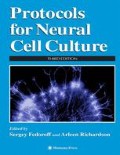Abstract
Cultures enriched in spinal somatic motoneurons are useful test systems for delineating the role of trophic factors in motoneuron survival and differentiation (e.g., McManaman et al., 1989, McManaman et al. 1990; Juurlink et al., 1991a; Henderson et al., 1994; Mettling et al., 1995; Kaal et al., 1997). They also form useful test systems for examining the roles of Fas receptor (Raoul et al., 1999) and thrombin receptor (Turgeon and Houenou, 1999) activation in motoneuron survival. Motoneurons in such cultures are obtained from embryonic spinal cord. There are basically two approaches whereby one can obtain cultures highly enriched in spinal motoneurons. One approach takes advantage of the fact that peripheral terminals of motoneurons can take up fluorescent labels and retrogradely transport these labels to the somas. Spinal cords can then be dissociated and labeled motoneurons isolated, using a fluorescence-activated cell sorter (e.g., Calof and Reichardt, 1984; Schaffner et al., 1987); this approach is labor-intensive and yields small numbers of neurons, of which only about 80% are labeled motoneurons. There are also questions concerning the effects of the tracer on the motoneurons (Smith et al., 1986). The second approach takes advantage of the fact that the buoyant density of motoneurons is significantly different from that of the other neural cell populations; here, motoneurons are separated from other cell populations by centrifuging cells through a density gradient (Schnaar and Schaffner, 1981; Dohrmann et al., 1986). This approach has the advantages that, technically, it is much simpler than the fluorescence-activated sorting method, and much larger numbers of motoneurons can be isolated. The cultures established from this latter approach, as described in this chapter, are free of nonneuronal cells, and are comprised of about 95% motoneurons as determined by calcitonin gene-related peptide immunocytochemistry (Juurlink et al., 1990).
Access this chapter
Tax calculation will be finalised at checkout
Purchases are for personal use only
Further Reading
Butler, H. and Juurlink B. H. J. (1987), An Atlas for Staging Mammalian and Chick Embryos, CRC, Boca Raton, FL, pp.1–218.
Calof, A. L. and Reichardt, L. F. (1984), Motoneurons purified by cell sorting respond to two distinct activities in myotube-conditioned medium. Dev. Biol. 106, 194–210.
Dohrmann, U., Edgar, D., Sendtner, M., and Thoenen, H. (1986), Muscle-derived factors that support survival and promote fiber outgrowth from embryonic chick spinal motor neurons in culture. Dev. Biol. 118, 209–221.
Hamburger, V. and Hamilton, H. L. (1951), A series of normal stages in the development of the chick embryo. J. Morph. 88, 49–92.
Henderson, C. E., Phillips, H. S., Pollock, R. A., Davies, A. M., Lemeulle, C., Armanini, M., Simmons, L., Moffet, B., Vandlen, R. A., Simpson, L. C., et al. (1994), GDNF: a potent survival factor for motoneurons present in peripheral nerve and muscle [see comments] [published erratum appears in Science 1995 Feb 10;267:777]. Science 266, 1062–1064.
Kaal, E. C., Joosten, E., A. and Bar, P. R. (1997), Prevention of apoptotic motoneuron death in vitro by neurotrophins and muscle extract. Neurochem. Int. 31, 193–201.
Juurlink, B. H. J., Munoz, D. G., and Devon, R. M. (1990), Calcitonin gene-related peptide identifies spinal motoneurons in vitro. J. Neurosci. Res. 26, 238–241.
Juurlink, B. H. J., Munoz, D. G., and Devon, R. M. (1991a), Muscle derived trophic factors promote the survival of motoneurons in vitro only when serum is present in the growth medium. Int. J. Neurosci. 58, 249–254.
Juurlink, B. H. J., Munoz, D. G., and Ang, L. C. (1991b), Motoneuron survival in vitro: effects of pyruvate, a-ketoglutarate, gangliosides and potassium. Neurosci. Lett. 133, 25–28.
McManaman, J., Crawford, R., Clark, R., Richker, J., and Fuller, F. (1989), Multiple neurotrophic factors from skeletal muscle: demonstration of effects of basic fibroblast growth factor and comparisons with the 22-kilodalton choline acetyltransferase factor. J. Neurochem. 53, 1763–1771.
McManaman, J. L., Oppenheim, R. W., Prevette, D., and Marchetti, D. (1990), Rescue of motoneurons from cell death by a purified skeletal muscle polypeptide: effects of the ChAT development factor, CDF. Neuron 4, 891–898.
Mettling, C., Gouin, A., Robinson, M., el M’Hamdi, H., Camu, W., Bloch-Gallego, E., Buisson, B., Tanaka, H., Davies, A. M., and Henderson, C. E. (1995), Survival of newly postmitotic motoneurons is transiently independent of exogenous trophic support. J. Neurosci. 15, 3128–3137.
Raoul, C., Henderson, C. E., and Pettmann, B. (1999), Programmed cell death of embryonic motoneurons triggered through the Fas death receptor. J. Cell. Biol. 147, 1049–1062.
Schaffner, A. E., St. John, P. A., and Barker, J. L. (1987), Fluorescence-activated cell sorting of embryonic mouse and rat motoneurons and their long term survival in vitro. J. Neurosci. 7, 3088–3104.
Schnaar, R. L. and Schaffner, A. E. (1981), Separation of cell types from embryonic chicken and rat spinal cord: characterization of motoneuron enriched fractions. J. Neurosci. 1, 204–217.
Smith, R. G., Vaca, K., McManaman, J., and Appel, S. H. (1986), Selective effects of skeletal muscle extract fractions on motoneuron development in vitro. J. Neurosci. 6, 439–447.
Turgeon, V. L. and Houenou, L. J. (1999), Prevention of thrombin-induced motoneuron degeneration with different neurotrophic factors in highly enriched cultures. J. Neurobiol. 38, 571–580.
Author information
Authors and Affiliations
Editor information
Editors and Affiliations
Rights and permissions
Copyright information
© 2001 Humana Press Inc., Totowa, NJ
About this protocol
Cite this protocol
Juurlink, B.H.J. (2001). Chick Spinal Somatic Motoneurons in Culture. In: Fedoroff, S., Richardson, A. (eds) Protocols for Neural Cell Culture. Springer Protocols Handbooks. Humana Press. https://doi.org/10.1385/1-59259-207-4:59
Download citation
DOI: https://doi.org/10.1385/1-59259-207-4:59
Publisher Name: Humana Press
Print ISBN: 978-0-89603-902-5
Online ISBN: 978-1-59259-207-4
eBook Packages: Springer Book Archive

